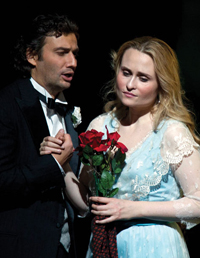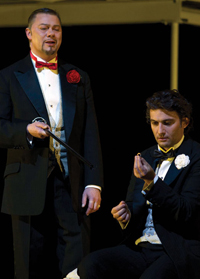|
|
|
|
|
|
|
|
| Opera News, February 2012 |
| DAVID J. BAKER |
|
|
|
Gounod: Faust, Metropolitan Opera New York, ab 29. November 2011 |
|
|
Faust, Metropolitan Opera
|
 
Photos: Beth Bergman
The Metropolitan Opera has
entrusted its latest staging of Gounod's Faust (a coproduction with English
National Opera) to Des McAnuff, a director accustomed to dusting off and
shaking up redoubtable theater classics. As a practiced Shakespearean,
McAnuff has dealt with works even more familiar to audiences than Gounod's
warhorse, with its Met track record of 700-plus performances since 1883,
when the opera opened the company's first home at Broadway and Thirty-ninth
Street.
|
The McAnuff production, first seen at ENO in September 2010 and introduced
to the Met on November 29, is contrarian yet predictable. It seems
determined to defy audience expectations, to force attention without
interpretive payoff. Each gesture seems to contradict the previous one; the
opera is updated, backdated and undated. The soldiers, costumed by Paul
Tazewell, appear to be fighting World War I, while the opera's churchgoers
and angel chorus wear white coats that suggest a pharmaceutical TV
commercial. Robert Brill's skeletal, monochrome metallic sets have the
barren utility of a lab or warehouse — or, increasingly, of standard opera
decors.
Many touches have an improvised quality, as if McAnuff were
playing with and discarding styles, mixing realism and magic, Dark Age
demons and New Age scientists, neon lights and exploding, romantic red
roses. The juxtaposition of science and superstition, in the lab setting
that frames the action, could be implicit satire. But without cumulative
impact or any sense of a unifying vision, the experiments remain decorative;
the framing device offers nothing but a hint of novelty — unfulfilled — and
a formal symmetry that is merely tidy.
But then there is Marguerite.
The production may have the brain of a clever student, but at heart it is
sentiment tinged with realism. With the heroine, all irony stops, though
McAnuff indulges in certain exaggerations. She is shown obviously,
enormously pregnant in Act IV, in a note of realism new to Gounod's opera
here, and her brother's outrage and death are played straight. With the
predictability of a Brechtian stage poster and all the subtlety of a North
Korean military parade, McAnuff mounts huge projections of the face of
Marina Poplavskaya, who plays Marguerite. Projected on the curtain at
intermission, the face proves, almost eerily, to be a video, not a still
projection; the eyes shift — as if hinting at depths that remain unexplored.
The surprise is how firmly and without apparent effort Poplavskaya
maintains focus on her character. The soprano, whose default stage demeanor
is a poised serenity, forms an immobile center surrounded by a swirl of
secondary activity. The ultimate impact, dramatically, is to consign the
hero to satellite status (an effect abetted by tenor Jonas Kaufmann's muted
performance) and to reduce the opera to its human, sentimental love story.
What makes this Faust distinctive, however, is musical — the
idiosyncratic approach that conductor Yannick Nézet-Séguin and his cast have
taken to the score. At the most extreme moments, audience members had to
lean forward to catch Faust's ardent, muffled phrases — owing partly to
Kaufmann's raspy vocal condition before he warmed up. It became apparent
soon enough that the whisper campaign was deliberate. Kaufmann used degrees
of piano and exaggerated rubato to convey a sense of wonder, suggesting a
rejuvenated Faust who can hardly believe his delight and his luck; in so
doing, he invited fresh attention to lines often taken for granted, such as
the abrupt "Je t'aime" after the first encounter with Marguerite, which was
almost frozen in time.
Nézet-Séguin's conducting favored long,
cohesive lines and, especially, transparent textures. Instrumental detail
has rarely been so clear and savory in these old standards — the gently
wafted violin solo in "Salut! demeure chaste et pure," the percolating
woodwinds so individualized in each stanza of Méphistophélès's serenade. The
orchestra never challenged the singers; the conductor's focus on clarity
gave duets a conversational quality.
Like Kaufmann at key moments,
but without affectation, the Méphistophélès, a superbly dapper René Pape,
made even secondary lines count. Pape's delivery of the quick aside to Faust
about Marguerite in her new finery ("as you can see, the jewels received a
warm welcome") turned the tricky twelve-note phrase into a lightning-quick
parenthesis in a stage whisper as suave as his Fred Astaire gestures. His
solo arias had an intriguing variety.
Both Pape and Kaufmann
complemented their refinement with robust delivery of big high notes,
although Kaufmann was more parsimonious, as if on a vocal budget, even at
the somewhat rushed peak moment in his aria.
Poplavskaya's singing
also lacked balance. She was clearly more comfortable at low volume in the
lyrical passages, where she produced an intimate glow that suited the
undulating lines, and she managed the delicate tracery of the jewel song,
including the extended trills, with skill. Loud high notes, on the other
hand, were attacked with a raw edge.
Russell Braun, as the
idealistic, hotheaded Valentin, was strained in big phrases, sounding
miscast in the famous cavatina and the "C'est une croix" ensemble. Michèle
Losier acted an appropriately puppyish Siébel, singing with a full, ruddy
tone that lacked something in finesse at quieter moments.
Directors
like to downsize and disperse the processions and mass rallies that figure
strongly, or once did, in grand opera. In McAnuff's intensely personal
focus, he keeps the chorus peripheral; they are sometimes looking on from
the sides, often heard but unseen. Unfortunately, though, the cramped
upstage placement of the choristers caused a certain loss of volume in the
Act III soldier's chorus and a damping of the music's intended impact.
The stripped-down final prison scene does the opposite; it modestly
makes way for Gounod. Rather than frustration, the minimalist presentation
brings a certain relief. Marguerite's prayers are not accompanied by any
bursts of light or religious iconography. The final blocking is symmetrical,
bare-bones geometry; Satan and his prey descend through a trapdoor, and the
heroine climbs, and keeps climbing, a long flight of stairs in a void, a
lone figure, obeying only the music.
|
|
|
|
|
|
|
|
|
|
|
|
|
|
|
|
|
|
|
|
|